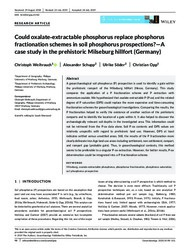Could oxalate-extractable phosphorus replace phosphorus fractionation schemes in soil phosphorus prospections?—A case study in the prehistoric Milseburg hillfort (Germany)
DOI: https://doi.org/10.1002/gea.21760
Persistent URL: http://resolver.sub.uni-goettingen.de/purl?gldocs-11858/9283
Persistent URL: http://resolver.sub.uni-goettingen.de/purl?gldocs-11858/9283
Weihrauch, Christoph; Schupp, Alexander; Söder, Ulrike; Opp, Christian, 2019: Could oxalate-extractable phosphorus replace phosphorus fractionation schemes in soil phosphorus prospections?—A case study in the prehistoric Milseburg hillfort (Germany). In: Geoarchaeology, Band 35, 1: 98 - 111, DOI: 10.1002/gea.21760.
 |
View/
|
A geoarchaeological soil phosphorus (P) prospection is used to identify a gate within the prehistoric rampart of the Milseburg hillfort (Hesse, Germany). This study compares the application of a P fractionation scheme and P extraction with ammonium-oxalate. We hypothesized that oxalate-extractable P (P-ox) and the related degree of P saturation (DPS) could replace the more expensive and time-consuming fractionation schemes for geoarchaeological investigations. Comparing the results, the P fractionation helped to verify the existence of another section of the prehistoric ramparts and to identify the location of a gate within it. It also helped to discover the archaeologically relevant soil depths in the investigated area. This information could not be retrieved from the P-ox data alone. Soil P-ox contents and DPS values are relatively unspecific with regard to prehistoric land use. However, DPS at least indicates settled versus unsettled areas. Still, the results of the P fractionation more clearly delineate Iron Age land use areas including settlement, non-settlement, rampart, and rampart gap (probable gate). Thus, in geoarchaeological contexts, this method seems to be preferable to a singular P-ox extraction. However, for better results, P-ox determination could be integrated into a P fractionation scheme.
Statistik:
View StatisticsCollection
Subjects:
Milseburgoxalate-extractable phosphorus
phosphorus fractionation
phosphorus saturation
soil phosphorus prospection
This is an open access article under the terms of the Creative Commons Attribution License, which permits use, distribution and reproduction in any medium, provided the original work is properly cited.

